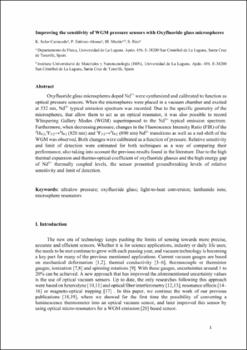Improving the sensitivity of WGM pressure sensors with Oxyfluoride glass microspheres
Fecha
2021Resumen
Oxyfluoride glass microspheres doped Nd3+ were synthesized and calibrated to function as
optical pressure sensors. When the microspheres were placed in a vacuum chamber and excited
at 532 nm, Nd3+ typical emission spectrum was recorded. Due to the specific geometry of the
microspheres, that allow them to act as an optical resonator, it was also possible to record
Whispering Gallery Modes (WGM) superimposed to the Nd3+ typical emission spectrum.
Furthermore, when decreasing pressure, changes in the Fluorescence Intensity Ratio (FIR) of the
2H9/2,
4F5/2→4
I9/2 (820 nm) and 4F3/2→4
I9/2 (890 nm) Nd3+ transitions as well as a red-shift of the
WGM was observed. Both changes were calibrated as a function of pressure. Relative sensitivity
and limit of detection were estimated for both techniques as a way of comparing their
performance, also taking into account the previous results found in the literature. Due to the high
thermal expansion and thermo-optical coefficient of oxyfluoride glasses and the high energy gap
of Nd3+ thermally coupled levels, the sensor presented groundbreaking levels of relative
sensitivity and limit of detection.






